
Parks respond to Deepwater Horizon oil spill
The British Petroleum Corp., known to most people as BP, faced a huge dilemma in April 2010 because of its Deepwater Horizon oil rig that exploded in the Gulf of Mexico. At the time, 11 people died out of 126 people who were on board.
The dilemma was not only the deaths of employees and destruction of a valuable oil rig, but also because of its potential environmental damage to the entire Gulf Coast of the U.S. as well as the tourism- and fishing-based economies of the region.
Several major U.S. national parks that have always presented the cultural and natural sides of their regions to millions of visitors each year were also placed at serious risk.
| Click on the video at the right to view an audio slideshow about the park system’s response to the oil spill prepared and narrated by writer Omar Aldakheel. |
The parks that were affected or potentially affected were Jean Lafitte National Historical Park in Louisiana, the Big Cypress National Preserve, Biscayne National Park, Gulf Islands National Seashore, Dry Tortugas National Park, De Soto National Memorial, and Everglades National Park in Florida.
In fact, the oil spill has affected the species, lands as well as visitors’ usage of the parks’ environments.
Oil was gushing from the rig’s well and the National Park Service areas along the Gulf prepared for the potential of large amounts of raw crude oil coming ashore. The NPS sites focused on reducing the impact of the land-bound oil on parks resources as much as possible, putting all of their prevention resources at work.
Since then, NPS staff continued on working closely with the unified response to the oil spill.
“The NPS staff has been doing a great job on protecting the national parks since last year,” said Linda Friar, PR of Everglades National Park. “We will post alerts to visitors on our website if potential danger might come to the Everglades.”
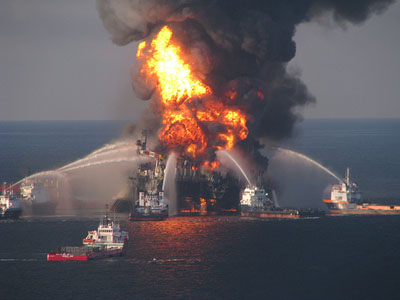 |
The British Petroleum rig Deepwater Horizon burns after an explosion in the Gulf of Mexico in April 2010 (Photos courtesy of Deepwater Horizon Response Team). |
The response included several not-for-profit organizations that helped spread awareness of the oil spill impact on the national parks and that demonstrated how voluntary efforts could help diminishing the largest oil spill damage of the U.S. history.
These organizations and groups include South Florida National Parks Trust, U.S. Fish and Wild Service, and the National Audubon Society.
First of all, the national parks’ response was taking an immediate action to examine water quality and environmental conditions for plant and animal life.
| National Park Service staff members help with cleaning beaches and rescuing marine species. | 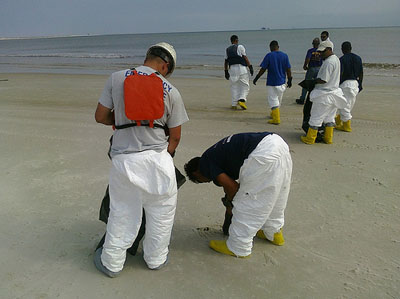 |
NPS’s expert observers and scientists from around the country came to the Gulf to help shoreline assessment teams check beaches for oil and recommend cleanup methods in order to remove oil without causing further harm to plants, animals, historic buildings or buried pieces.
“The reason why we are so worried about this place at the Everglades National Park and that so many people here concerned about what happen here in the shallow water near the shore is this is the nursery area for all of the species that people eat, such as shrimp and fish, and it is all through the Gulf of Mexico,” said Gary Davis, NPS retired, lead resources advisor for the NPS South Florida oil spill response team.
The South Florida National Parks Trust response was providing more donations to its partner parks in Florida to support resource protection, visitor services, and volunteer activities.
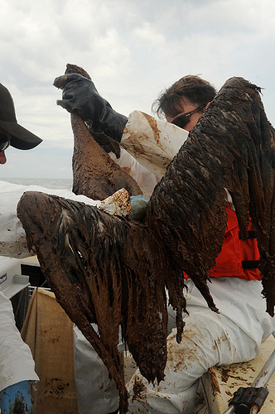 |
At left, one of the marine birds that was affected by the oil spill is rescued by the National Park Service experts. Next, an expert from the National Park Service is checking on water that was affected by the oil spill. Next, experts from the National Park Service rescue Gulf turtles. |
“Since the Trust was established in 2002 our purpose was to support South Florida’s national parks through fund-raising and community outreach,” said Don Finefrock, executive director of South Florida National Parks Trust.
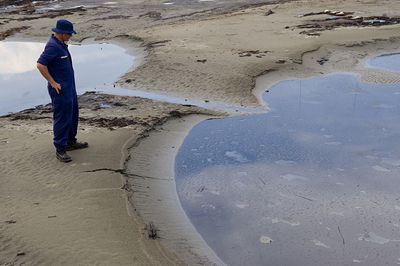 Since its mission is “to work with others to conserve, protect, and enhance fish, wildlife, and plants, and their habitats for the continuing benefit of the American, people,” the U.S. Fish and Wildlife Service response was to protecting habitats and sensitive species, leading the survey, rehabilitation of oiled wildlife, supporting the incident command in planning clean up actions, and measuring damage to natural resources.
Since its mission is “to work with others to conserve, protect, and enhance fish, wildlife, and plants, and their habitats for the continuing benefit of the American, people,” the U.S. Fish and Wildlife Service response was to protecting habitats and sensitive species, leading the survey, rehabilitation of oiled wildlife, supporting the incident command in planning clean up actions, and measuring damage to natural resources.
The National Audubon Society response was sending their Initiative staff to the scene to measure the impacts and help organize the emergency response.
“As Audubon’s director of Bird Conservation, I’m focused on what Audubon can do to help bird populations over time and how we can help document the loss of birds to the oil spill and their long-term recovery,” 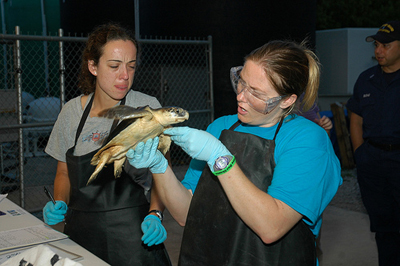 said Greg Butcher, director of Bird Conservation for the National Audubon Society.
said Greg Butcher, director of Bird Conservation for the National Audubon Society.
Finally, the BP responded by agreeing to pay $20 billion in oil spill response fund. Also, BP primarily promised to pay all those affected.
BP Chief Executive Officer Bob Dudley promised to continue long-term financial support for people affected by the catastrophic Deepwater Horizon oil rig spill.
“We have written about 80,000 checks, more than a quarter billion dollars, but we realize this is not perfect and there’s more to go,” Dudley said at a televised press conference in Biloxi, Miss.

Comments are Closed